| |
The role of NNRTIs in treatment experienced patients - an update on TMC125
|
| |
| |
Reported by Jules Levin
B Woodfall, M Peeters, J Vingerhoets, T Kakuda, B Baeten
HIV DART, Cancun, Mexico, 10-14 December 2006.
Brian Woodfall from Tibotec provided this review on TMC125 at HIV-DART.
INTRODUCTION
Treatment guidelines reflect the well established data for the use of current NNRTIs in treatment naive patients1
Limited or negative data exists for the efficacy of current NNRTIs in treatment experienced patients
Data on the use of current NNRTIs in patients with primary NNRTI resistance is also limited
Unmet medical need to expand the class for the treatment experienced population, including those with NNRTI resistance
Positive Phase II data has been generated with TMC125 as a potential option in these patients2
1. DHHS, Guidelines for the use of antiretroviral agents in HIV-1 infected adults and adolescents; October, 2006.
2. Cohen C, et al. XVIth IAC 2006 (TUPE0061
NNRTI treatment experienced patients
In vitro virology does not support treatment of NNRTI-resistant virus with the current NNRTIs
-- In vitro, EFV is active (low EC50) against Y181C mutation but this is not substantiated in clinical data1
No randomized clinical trials have been done with current NNRTIs in this setting
-- Data from EFV expanded access program demonstrated low rates of virologic suppression
-- 18% in the ITT population achieved pVL <400 copies/mL after 6 months of treatment2
1. Antinori A, et al. AIDS Res Hum Retrovir 2002; 18: 835-838.
2. Bacheler L, et al. 39th ICAAC 1999 (Abstract #2201)
Primary NNRTI resistance
EFV in primary NNRTI resistance - Gilead 934 trial: treatment outcomes and development of mutations in patients with baseline NNRTI resistance
11 patients on FTC+TDF & 11 on Combivir had baseline NNRTI resistance identified in study 934. 4-5 patients in each group discontinued by week 48 with >400 c/ml and they mostly had M184 and EFV mutations.
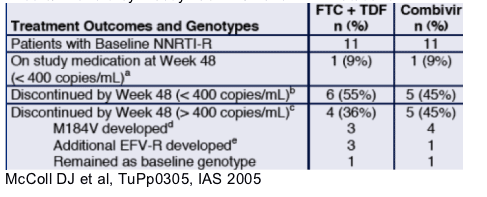
TMC125 Studies reviewed
C207
Short term proof of principle trial in patients with NNRTI resistant virus
C203
Phase II dose escalation safety study in 3-class experienced patients
C227
Phase II exploratory trial in first-line NNRTI failures
C223
Phase II dose finding efficacy trial in heavily pre-treated patients with extensive multi-drug resistance
TMC125 In vitro Virology Data
High potency and selectivity against wild type HIV
-- EC50 = 1.4 nM (0.61 ng/ml)
-- CC50 > 100 μM
Active against HIV-1 with single and double NNRTI-resistant mutations
-- K103N, Y181C, K103N+Y181C
High potency against NNRTI-resistant clinical isolates
-- EC50 below 10 nM for > 80% of ∼2,000 NNRTI resistant clinical isolates
Increased genetic barrier to development of HIV drug resistance
-- In vitro selection experiments show virus breakthrough delayed or prevented by TMC125
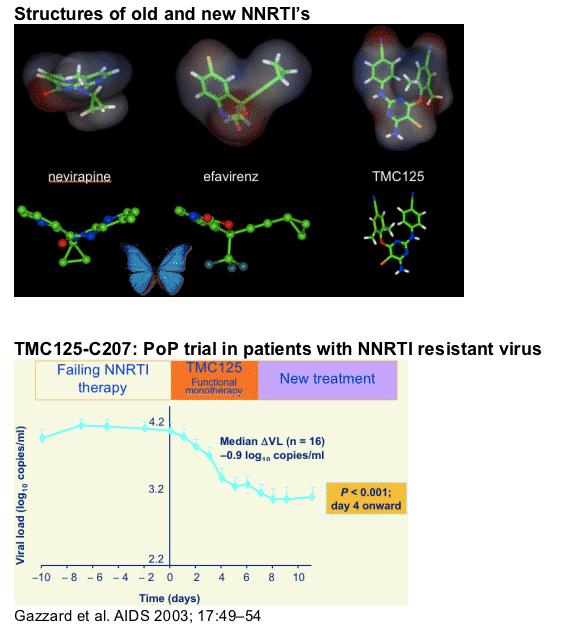
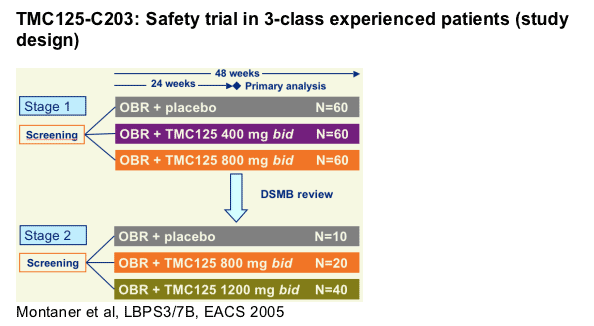
TMC125-C203 Conclusions
TMC125 was generally safe and well tolerated in this study
-- Grade 3/4 AEs - not substantially different from placebo
-- Most common AEs were diarrhoea, headache, rash and nausea
-- Rashes were generally mild to moderate
-- No consistent or frequent neuropsychiatric syndrome associated with TMC125
The TMC125-C223 dose-finding study was designed and conducted based on these data.
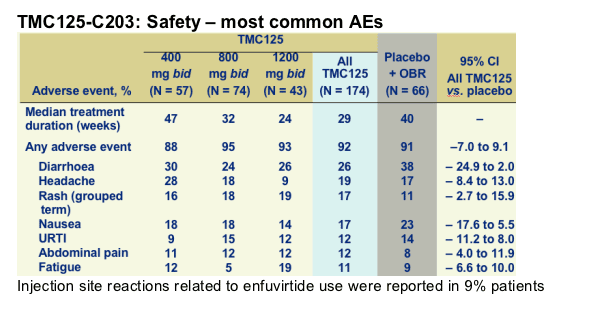
TMC125-C203: Rash
Overall incidence:
-- 17% TMC125 vs. 11% placebo (95% CI: -2.7 to 15.9)
-- No dose differentiation
Relatedness and severity:
-- At least possibly related to TMC125: 8%
-- Grade 3 rash plus fever: 1 in 400 mg group; no SAEs
-- No Stevens-Johnson syndrome, toxic epidermal necrolysis or
erythema multiforme
Permanent discontinuation:
-- 3 (2%) TMC125 vs. 1 (2%) placebo
Time to onset / duration (at least possibly related rash):
-- Median time to onset 13 days and median duration 4 days
No association between rash and higher baseline CD4 cell count
No difference in the incidence of rash between male and female patients receiving TMC125
TMC125-C203: neuropsychiatric summary
Nervous system disorders occurred in 40% of TMC125-treated patients and 35% of placebo-treated patients
-- the most common nervous system AEs were headache, dizziness and insomnia. Only dizziness was more common compared with placebo
-- headache, dizziness and insomnia generally occurred within the first month of TMC125 administration
-- there was no association between TMC125 dose and incidence or severity of nervous system events
Psychiatric AEs occurred in 13% of TMC125-treated patients and 11% of placebo-treated patients
-- the most common psychiatric AEs were depression, anxiety and sleep disorder; the incidence was low and not different from placebo
-- there was no pattern in the time of onset for the most common psychiatric events
-- for TMC125-treated patients, there was an overall trend for increased incidence with the highest dose (1,200mg bid). A pre-trial history of psychiatric disorder(s) was also most frequent in the TMC125 1,200mg bid group

-- PI naive
-- NNRTI experienced, screening viral load >1,000c/mL
-- >/= 1 NNRTI resistance associated mutation (historical or at screening)
-- Active control group: investigator-selected PI
-- 95% used boosted PI (61% LPV/r, 32% ATV/r)
-- Both control and TMC125 groups: investigator-selected two NRTIs based on screening vircoTYPE HIV-1
-- TMC125 arm discontinued after DSMB review
TMC125-C227: Baseline detectable NRTI mutations
A large number of NRTI resistance-associated mutations were noted in this first line failure population.
Many NRTIs were recycled in this study.
In the TMC125 group:
-- 37% recycled one, 9% two
In the Control group:
-- 35% recycled one, 12% two
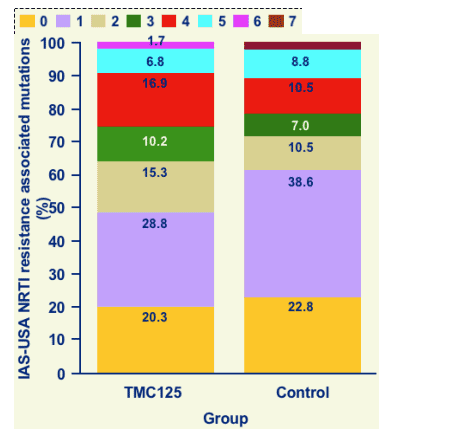
TMC125-C227: Baseline detectable NNRTI mutations
A large number of NNRTI mutations were noted in this first line failure population.
All patients had NNRTI mutations at screening or from prior genotyping.
Median fold change to:
Efavirenz 129.8
Nevirapine 88.0
TMC125 2.0
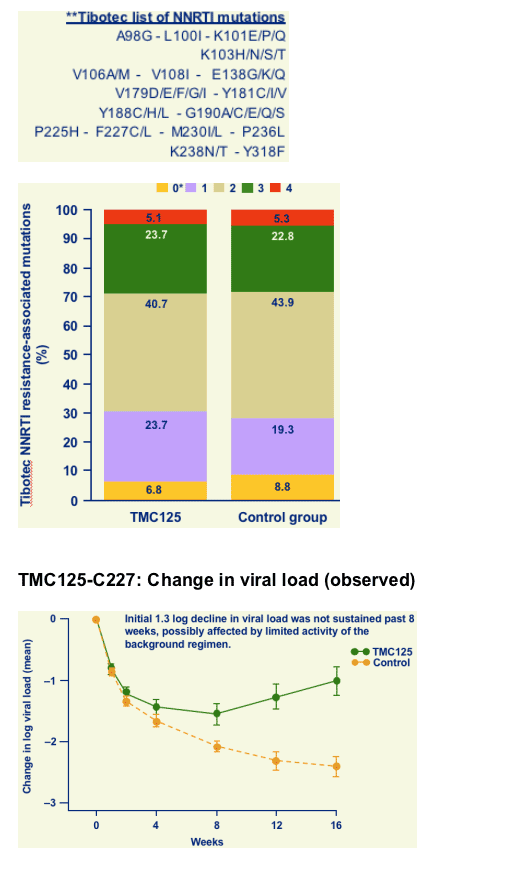
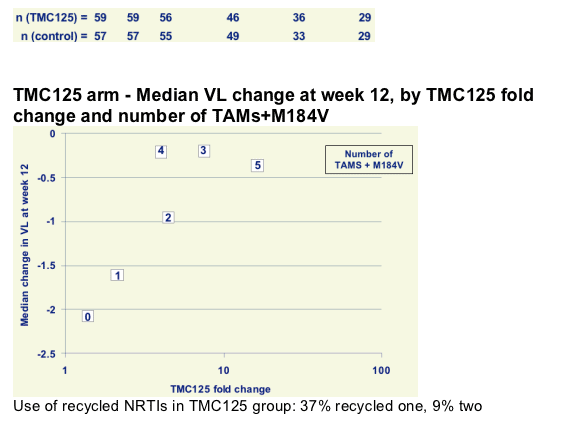
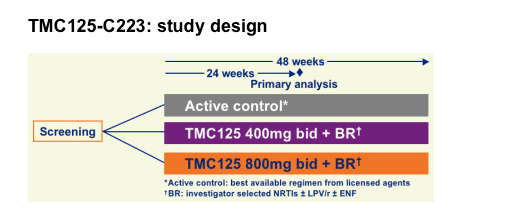
TMC125-C227 Conclusions
The level of both NRTI and NNRTI resistance was higher than what might have been expected from a first-line failure population
Many patients recycled previously used NRTIs
Increasing numbers of TAMs and M184V were associated with increased NNRTI resistance
The combination of high level NRTI and NNRTI resistance adversely impacted the TMC125 arm
Less likely to have affected the PI arm in this PI-naive population
Consistent with treatment guidelines, patients failing a first-generation NNRTI should immediately switch their regimen to avoid the accumulation of multi-class resistance
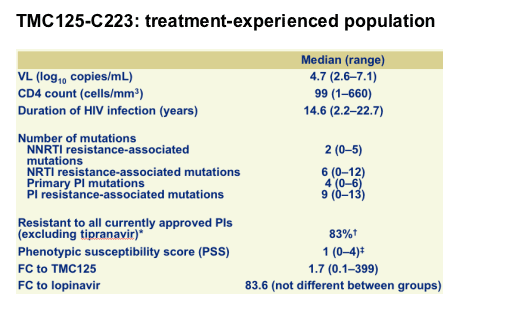
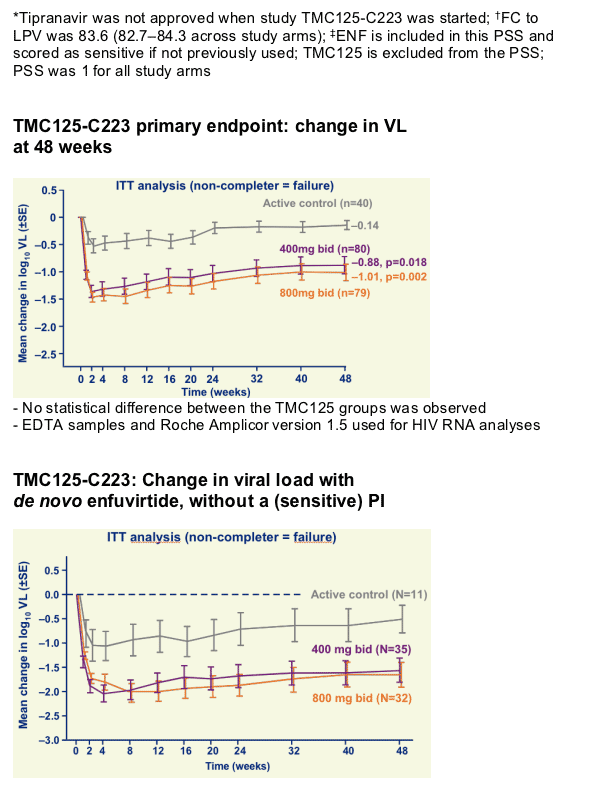
-- Documented NNRTI resistance and ≥3 primary PI mutations
-- Partially blinded, US, randomization 1:2:2 (active control versus 400mg bid versus 800mg bid)
-- VL >1,000 copies/mL
Cohen et al, TUPE0061, IAC 2006
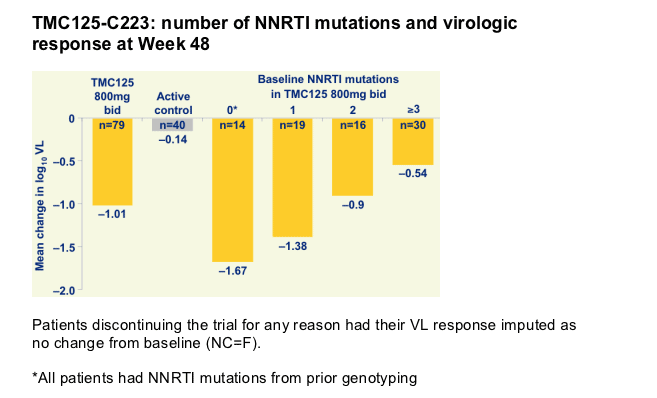
Interaction Data: TMC125 and other ARVs
ALLOWED
No dose adjustment
NRTIs
-- TDF
-- ddI
RTV boosted PIs
-- ATV
-- DRV
-- LPV
-- SQV
-- LPV/SQV
Dose adjustment may be required
-- fosAPV/r
NOT RECOMMENDED
NNRTIs
-- EFV
-- NVP
TPV/r
RTV (full dose)
Unboosted PIs
-- ATV
-- IDV
Interaction Data - TMC125 and other drugs
ALLOWED
pH modifiers
-- omeprazole
-- ranitidine
Methadone
Oral contraceptives
Ranitidine
Clarithromycin
-- Alternative should be considered for treatment of MAC
Dose adjustment may be required
Sildenafil

Two identical Phase III trials in heavily treatment experienced patients
Randomized, double blind, placebo controlled
*Background regimen: DRV/r + Investigator selected NRTIs +/- ENF
Primary objective: TMC125 superior over placebo for proportion of subjects with undetectable viral load (<50 copies/ml)
TMC125 dosed at 200 mg bid (new formulation) which provides comparable exposure to 800 mg bid (Phase II formulation) selected from the Phase II program
TMC125: other ongoing activities
Phase I interaction trial with investigational agents ongoing or planned
-- MK0518, maraviroc, GS-9137
Early Access Program (EAP) open and enrolling in 11 countries
-- Additional countries and sites added on ongoing basis
Pediatric dose finding
-- HIV-1 infected children/adolescents age 6-18 inclusive
|
|
| |
| |
|
|
|